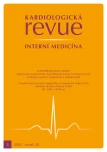Commented shortened version of the 2018 ESC Guidelines for the diagnosis and management of syncope
Authors:
P. Heinc; K. Vykoupil; R. Nykl; Š. Hudec; R. Aiglová; L. Rec
Authors‘ workplace:
I. interní klinika – kardiologická, Fakultní nemocnice Olomouc
Published in:
Kardiol Rev Int Med 2018, 20(3): 197-207
Overview
New European Guidelines for the diagnosis and management of syncope have been issued to provide a consistent and systematic approach to patients with a temporary loss of consciousness. This article summarises and comments upon the classification, diagnostic, therapeutic and organisational rules for the healthcare provided to these patients. The shortened and commented version of the new recommendations is intended to provide greater clarity for practical use.
Key words:
syncope – classification – diagnostic principles – risk stratification – treatment – healthcare organisation
Sources
1. Brignole M, Moya A, de Lange FJ et al. 2018 ESC Guidelines for the diagnosis and management of syncope. Eur Heart J 2018; 39(21): 1883– 1948. doi: 10.1093/ eurheartj/ ehy037.
2. Brignole M, Moya A, de Lange FJ et al. Practical Instructions for the 2018 ESC Guidelines for the diagnosis and management of syncope. Eur Heart J 2018: 39(21): e43– e80. doi: 10.1093/ eurheartj/ ehy071.
3. Mosqueda-Garcia R, Furlan R, Tank J et al. The elusive pathophysiology of neurally mediated syncope. Circulation 2000; 102(23): 2898– 2906.
4. Morillo CA, Eckberg DL, Ellenbogen KA et al. Vagal and sympathetic mechanisms in patients with orthostatic vasovagal syncope. Circulation 1997; 96(8): 2509– 2513.
5. Alboni P, Furlan R. Vasovagal syncope. Heidelberg: Springer 2015: 3– 17.
6. Freeman R, Wieling W, Axelrod FB et al. Consensus statement on the definition of orthostatic hypotension, neurally mediated syncope and the postural tachycardia syndrome. Clin Auton Res 2011; 21(2): 69– 72. doi: 10.1007/ s10286-011-0119-5.
7. Fedorowski A, Melander O. Syndromes of orthostatic intolerance: a hidden danger. J Intern Med 2013; 273(4): 322– 335. doi: 10.1111/ joim.12021.
8. Palma JA, Gomez-Esteban JC, Norcliffe-Kaufmann Let al. Orthostatic hypotension in Parkinson disease: how much you fall or how low you go? Mov Disord 2015; 30(5): 639– 645. doi: 10.1002/ mds.26079.
9. Lagro J, Schoon Y, Heerts I et al. Impaired systolic blood pressure recovery directly after standing predicts mortality in older falls clinic patients. J Gerontol A Biol Sci Med Sci 2014; 69(4): 471– 478. doi: 10.1093/ gerona/ glt111.
10. Fedorowski A, Li H, Yu X et al. Antiadrenergic autoimmunity in postural tachycardia syndrome. Europace 2017; 19(7): 1211– 1219. doi: 10.1093/ europace/ euw154.
11. van Dijk JG, Thijs RD, Benditt DG et al. A guide to disorders causing transient loss of consciousness: focus on syncope. Nat Rev Neurol 2009; 5(8): 438– 448. doi: 10.1038/ nrneurol.2009.99.
12. Keller K, Beule J, Balzer JO et al. Syncope and collapse in acute pulmonary embolism. Am J Emerg Med 2016; 34(7): 1251– 1257. doi: 10.1016/ j.ajem.2016.03.061.
13. Wieling W, Thijs RD, van Dijk N et al. Symptoms and signs of syncope: a review of the link between physiology and clinical clues. Brain 2009; 132(Pt 10): 2630– 2642. doi: 10.1093/ brain/ awp179.
14. Moya A, Permanyer-Miralda G, Sagrista-Sauleda Jet al. Limitations of head-up tilt test for evaluating the efficacy of therapeutic interventions in patients with vasovagal syncope: results of a controlled study of etilefrine versus placebo. J Am Coll Cardiol 1995; 25(1): 65– 69.
15. Flammang D, Church TR, De Roy L et al. ATP Multicenter Study. Treatment of unexplained syncope: a multicenter, randomized trial of cardiac pacing guided by adenosine 5’-triphosphate testing. Circulation 2012; 125(1): 31– 36. doi: 10.1161/ CIRCULATIONAHA.111.022855.
16. Bass EB, Curtiss EI, Arena VC et al. The duration of Holter monitoring in patients with syncope. Is 24 hours enough? Arch Intern Med 1990; 150(5): 1073– 1078.
17. LaFrance WC Jr, Baker GA, Duncan R et al. Minimum requirements for the diagnosis of psychogenic nonepileptic seizures: a staged approach: a report from the International League Against Epilepsy Nonepileptic Seizures Task Force. Epilepsia 2013; 54(11): 2005– 2018. doi: 10.1111/ epi.12356.
18. Tannemaat MR, van Niekerk J, Reijntjes RH et al. The semiology of tilt-induced psychogenic pseudosyncope. Neurology 2013; 81(8): 752– 758. doi: 10.1212/ WNL.0b013e3182a1aa88.
19. Brignole M, Menozzi C, Bartoletti A et al. A new management of syncope: prospective systematic guideline-based evaluation of patients referred urgently to general hospitals. Eur Heart J 2006; 27(1): 76– 82. doi: 10.1093/ eurheartj/ ehi647
20. Sarasin FP, Junod AF, Carballo D et al. Role of echocardiography in the evaluation of syncope: a prospective study. Heart 2002; 88(4): 363– 367.
21. Kenny RA, Brignole M, Dan GA et al. Syncope Unit: rationale and requirement – the European Heart Rhythm Association position statement endorsed by the Heart Rhythm Society. Europace 2015; 17(9): 1325– 1340. doi: 10.1093/ europace/ euv115.
22. Verheyden B, Liu J, van Dijk N et al. Steep fall in cardiac output is main determinant of hypotension during drug-free and nitroglycerine-induced orthostatic vasovagal syncope. Heart Rhythm 2008; 5(12): 1695– 1701. doi: 10.1016/ j.hrthm.2008.09.003.
Labels
Paediatric cardiology Internal medicine Cardiac surgery CardiologyArticle was published in
Cardiology Review

2018 Issue 3
Most read in this issue
- Perindopril and cardiovascular disease – 25 years of success in cardiology
- Hypothyroidism and the heart
- Gestational diabetes mellitus and possibilities for its treatment
- Commented shortened version of the 2018 ESC Guidelines for the diagnosis and management of syncope
